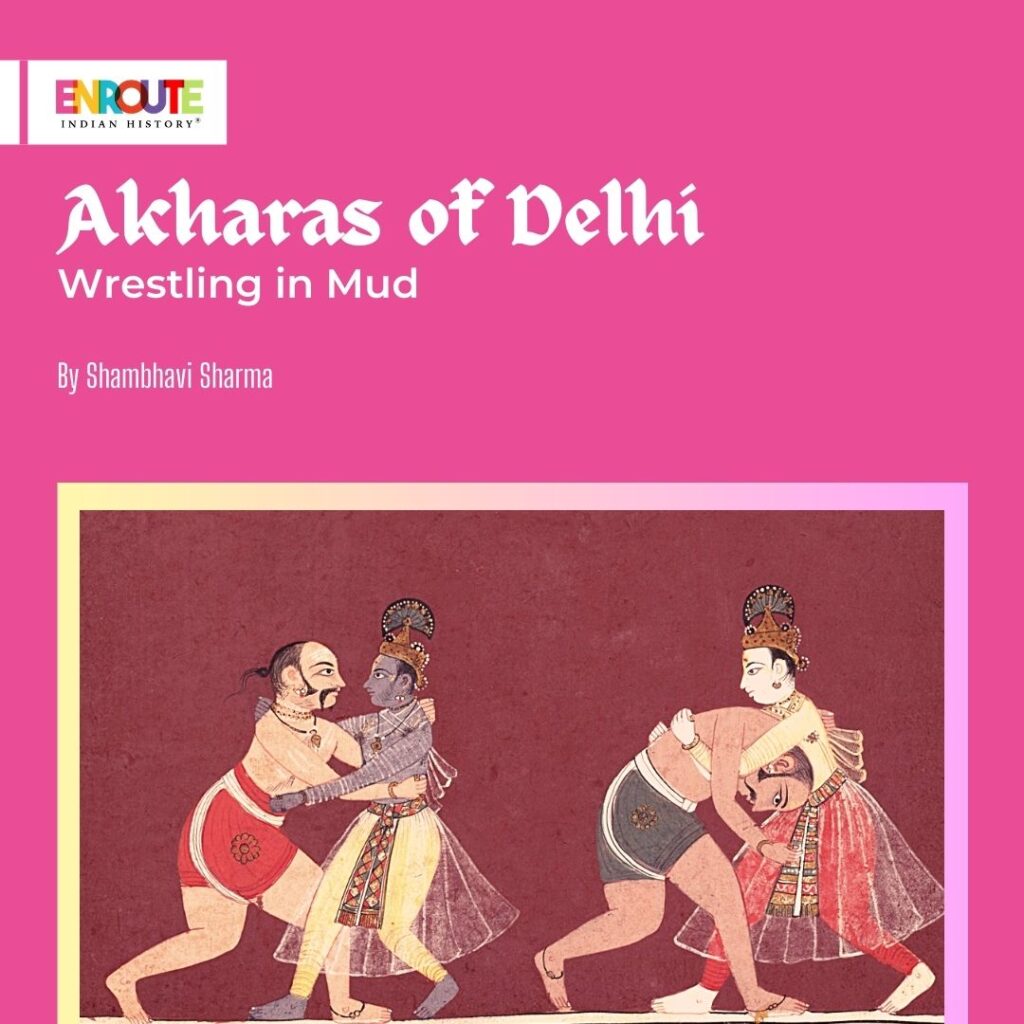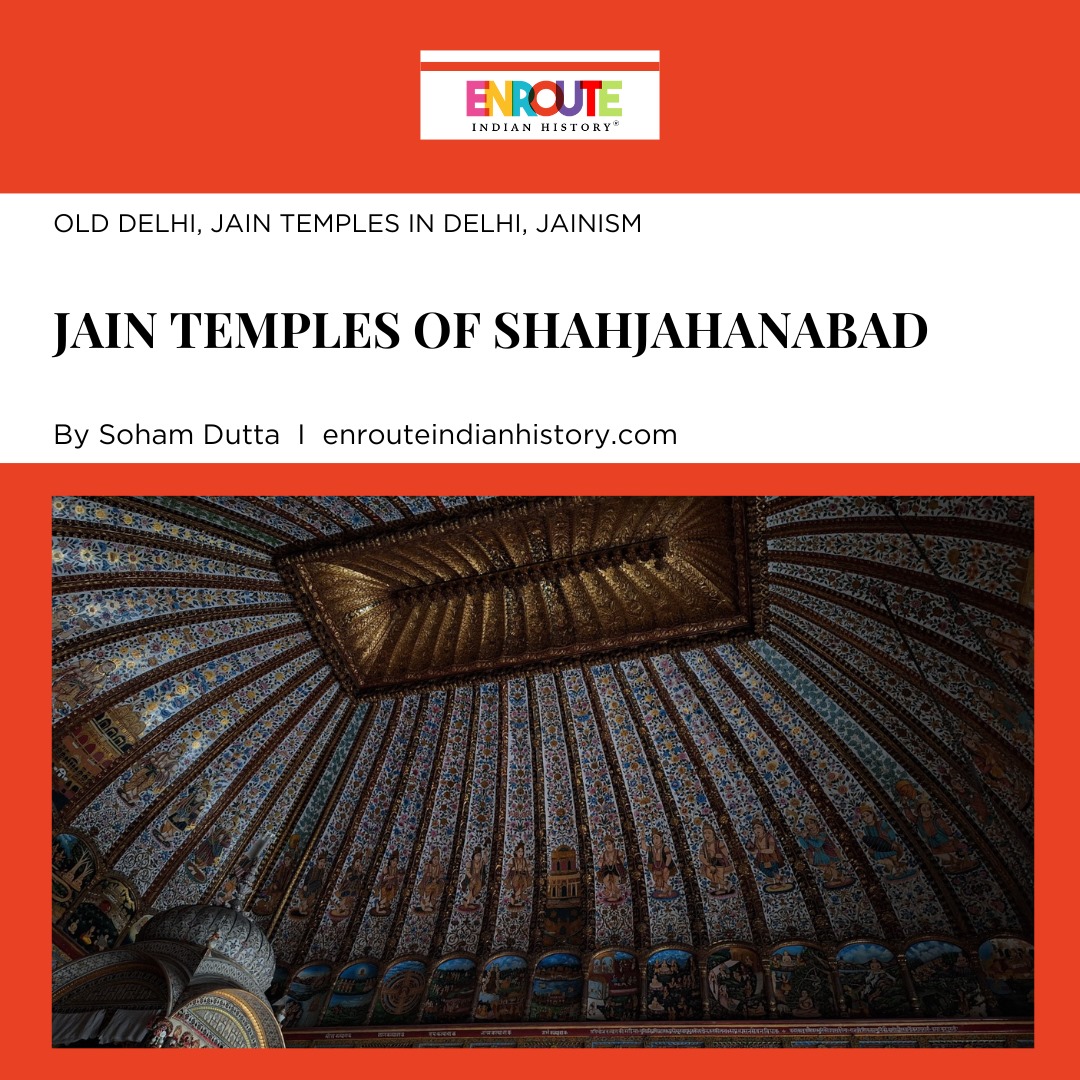
Delhi is home to many Akdaras or training grounds for wrestlers. Wrestling known as Kushti or Pehlwani in Hindi is a traditional form of combat martial art in India that can trace back its lineage to “Malla-Yuddha” (where “Malla” means wrestlers/boxers and “Yuddha” means combat) which finds its mention in the text of Ramayana; battle between Vali and Sugriva, and the battle between Sugriva and Ravana (Ramayana Vol-4: 730; Ramayana Vol.-6:1214; Vyas 1967:232). Even Chapters 23 and 24 of the Mahabhrata’s Sabha Parva include information regarding the deadly wrestling encounter between Bhima and Jarsandha. (Mahabharata vol. 1- Sabha Parva: 354). In the Bhagvata Purana and Harivamsa Purana, Balarama, Jarasandha, and Krishna are also said to have been master wrestlers. Krishna defeated his evil uncle Kansa, the king of Mathura in a match of wrestling.

[KRISHNA AND BALARAMA FIGHT THE EVIL KING KAMSA’S WRESTLERS: PAGE FROM A DISPERSED BHAGAVATA PURANA , 1650 , THE MET MUSEUM]
Among secular works, Panini refers to the term Sangraha i.e. gripping in wrestling. Even Patanjali calls it MallasyaSangraha and MustikasyaSangraha. Malla-Yuddha finds a detailed description in the 13th century Malla-Purana of the Jyesthimalla, a Gujarati Brahmin wrestling Jati, as a form of combat which was fought until death. A treatise on kingly fine arts and recreation, the Manasollasa, written by the Chalukya king Someswara II outlines the classification of wrestlers into categories. The king was in charge of giving the wrestlers beans, meat, milk, sugar, and “high-class sweets.” The wrestlers were required to dedicate their time to developing their physique while being kept apart from the court’s females.
The genesis of modern-day Kushti in Delhi happened during the Mughals who ruled northern India in the sixteenth century. The etymology of “Kushti” and “Pehlwani” can be traced from the Persian terms pahlavani (heroic) and koshti ( killing).

[THE EMPEROR SHAH JAHAN WATCHING A WRESTLING MATCH, ATTRIBUTABLE TO MIR KALAN KHAN, DELHI OR LUCKNOW, CIRCA 1750 | SOTHEBYS]
Though the art of Malla-Yuddha transformed into Kushti, the concept of akharas remained unchanged. akharas are traditional gymnasiums or training centers with lodging facilities for wrestlers ie., wrestlers live and train at the same place. the epic Mahabharata cites Jarasandha’s Akhara at Rajgir.
LIFE IN THE MUD PITS OF DELHI AKHARAS:
Delhi is home to several notable akharas, each carrying its unique legacy.
Chandgi Ram Akhara, located in New Delhi, holds a significant place in the history of Indian wrestling, especially in promoting women’s wrestling in the country. The akhara was established by the renowned wrestler Master Chandgi Ram, who was an Arjuna Award recipient and a gold medalist in the 1970 Asian Game. He secured prestigious titles in traditional Indian wrestling, including Hind Kesari, Bharat Kesari, Bharat Bhim, Rustom-e-Hind, and Maha Bharat Kesari. Under his guidance, many women wrestlers received training and went on to become prominent coaches in the country such as Neha Rathi, a bronze medallist at the 2012 Asian Games, and Sonika Kaliraman, a silver medalist at the 2003 junior Asian Games.
Another prominent akhara is the Guru Hanuman Akhara, considered the oldest surviving wrestling school in India, established in 1925. Located at Shakti Nagar near Roshanara Bagh in New Delhi, it serves as a breeding ground for top Indian wrestlers. It was established by wrestling legend Padma Shri Guru Hanuman, whose actual name was Vijay Pal Yadav, born on 15th March 1901 in Chirawa, Rajasthan. He started from the local village Akharas and went on to become a renowned wrestler in Delhi. His success as a wrestler and his passion for the sport led him to establish the Guru Hanuman Akhara in Malkaganj, Subzi Mandi (Old Delhi), around 1925, thanks to the support of Indian industrialist K. K. Birla.
This Delhi akhara churned out some of the most well-known wrestlers including Dara Singh, Guru Satpal, Sushil Kumar, Yogendra Kumar, Anuj Chowdhary, Rajiv Tomer, and others. Despite the government offering larger land with improved facilities, most wrestlers at the Akhara refused to shift, firmly believing the land to be blessed. Nonetheless, the government built a modern gymnasium at a distance from the Akhara, which is now utilized by some trainees.
Guru Jasram Akhara, located on Mathura Road Highway in Delhi, stands as one of India’s largest and most renowned Akharas shaping the careers of numerous wrestlers. Founded and run by Guru Jasram ji, who himself has won the prestigious ‘Bharat Kesari’ title multiple times, this akhara has produced 8 ‘Bharat Kesari winners, 5 international wrestlers, 6 ‘Arjuna awardees,’ and 2 ‘Dronacharya awardees.’
In Delhi, there are other prominent akharas that have contributed significantly to the world of wrestling such as Guru Rajkumar Goswami Akhara, located at Gokalpur, Delhi, led by Guru Rajkumar Goswami, and Chhatrasal Stadium, situated at Gujranwala Town, Delhi etc.
Traditionally Kushti, Pehlwani, is practiced on a clay or dirt pit that is at least 20 feet across, and either square or round in shape with 3 feet of mud in it. Ideally, Red soil is used in the mud pit.
This mud pit is considered sacred. Many ingredients are mixed with the soil to prepare it for the Indian sport of Kushti.
One of the main items added to the pit is Ghee or clarified butter. Along with it other ingredients like Nuts oil/mustard oil are mixed. Nut oil is known to absorb quickly into the skin, leaving a light, velvety, protective barrier on the skin. The sand remains cool and no dust is created which helps the wrestlers. Curd and buttermilk are added for nutritive content as well. Lemon juice is added to the soil for gentle exfoliation and neutralizing environmental damage to the soil.. Kapoor or Camphor is added for cooling sensation, Camphor is known to relieve symptoms such as pain and irritation. It can be used in soothing backaches and muscle pain as well. It is also known for its ability to reduce redness and irritation. Thai helps wrestlers practice for polonged period of time. Turmeric which is useful in disinfecting cuts, burns, and psoriasis is mixed as well, it helps heal and prevent dry skin and improves skin’s elasticity while sparring. Sometimes, the Color agent is added to make the sand brighter in appearance. Neem leaves powder is added to treat minor wounds it also reduces the chance of getting a further infection, if any wresler is injured during the fight. Chandan powder (sandalwood) is intermixed in the soil for its medicinal properties which are useful for treating several health problems and fighting skin infections. It has a calming effect on the nerves, and hence, proved to be beneficial to relieve stress, anxiety, irritability, etc. Finally, when water is put in, the mud becomes almost marshy and no dust is created.
Thus we can see, the soil content takes care of wrestlers’ health as well as improves performance. Each ingredient has its own special benefits. When these ingredients are mixed in the soil, wrestlers get their benefits through the soil. This a major reason the soil of the pit is revered.
The mud floor is cleared of any pebbles or stones before training. To maintain the ideal consistency—soft enough to prevent damage but hard enough for wrestlers’ agile movements—water is added every three days. Flattening the ground before a wrestling match is seen as both an exercise in self-discipline and endurance training.
Wrestlers bless themselves and their opponents during practice by throwing a couple of handfuls of dirt onto them; This shows that the very soil or mitti of the ground they practice is sacred. this also helps them get a better grip. Then a prayer is made to the gym’s patron god, who is typically Hanuman and Bhudevi (Goddess of the land/soil). There is a modest altar in the training room where the god is offered flower garlands and incense which again emphasizes the sacredness of the mud pit.
The Official Journal of the International Network of Wrestling Researchers (INWR) “International Journal of Wrestling Science” mentions the benefits of Mud wrestling including improved muscular strength, coordination, balance, and muscular endurance.
While the government has made efforts to provide modern training facilities for pehlwans, many wrestlers of Delhi Akharas still prefer sparring on mud due to its historical significance and the belief that it hones their skills and strength in a more authentic way. Mud wrestling not only connects them to their cultural roots but also offers a unique experience that they find essential for excelling in their sport.
REFERENCES:
- Nangare, V. P. (2013). TRADITIONAL SPORT: MUD WRESTLING & MUD PREPARATION. The Official Journal of the International Network of Wrestling Researchers (INWR): International Journal of Wrestling Science, Vol 3, Issue 1, 154-155.
- Dhebar, K. (2016). Wrestling in Indian Literature. Heritage: Journal of Multidisciplinary Studies in Archaeology, 4, 251-260.
- Mujumdar, D.C. 1950. Encyclopedia of Indian Physical Culture. Baroda: Good Companions Baroda India.
- Tokarski, S. (2011). Kalaripayatt, Kushti, and the Indian Warfare. Journal of Combat Sports and Martial Arts, 1(2), 53-56.
- Alter, J. S. (1992). The Wrestler’s Body: Identity and Ideology in North India. University of California Press.
- James G. Lochtefeld (2002). The Illustrated Encyclopedia of Hinduism: A-M. The Rosen Publishing Group. pp. 23–4
- https://anandfoundation.com/akhara /
- https://www.indiatoday.in/mail-today/story/delhi-akhara s-wrestling-jagbir-singh-wfi-1027077-2017-07-30
- https://anandfoundation.com/guru-jasram-akhara /

























